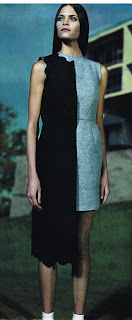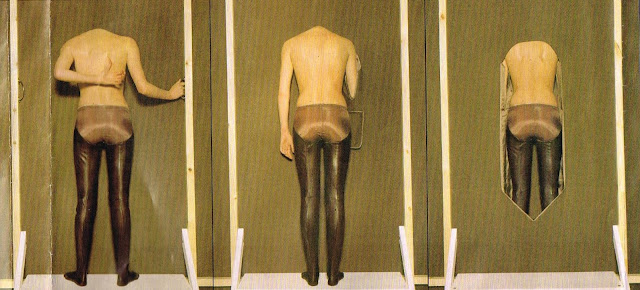This theme was sparked off by one of my Yr. 12 students, who is working on a 'shift dress'....a shift dress is less fitted around the waist and hips, "straight lines sweet and waifish", generally a short sleeveless simple style with little detailing. The bottom hem section has a wider skirt than the top part....think Mia Farrow, Twiggy, Audrey Hepburn, (they were all very "waifish")


but, in this blog, I actually want to feature the sheath dress silhouette. It is a form fitting, body clinging style, with pretty much identical measurements at both bust and knee.
This website has good pictorial examples of various dress styles (sheath and shift both feature.)
https://en.wikipedia.org/wiki/Dress#/media/File:StateLibQld_2_168647_Miss_May_Goggs,_a_Brisbane_Debutante_in_1900.jpg
CdG often works with the sheath dress style, but before I go there, let's look at RK's infamous "Body Meets Dress, Dress Meets Body".
It is a fascinating 1997 S/S collection that was also known as "Lumps & Bumps".
This collection was all about "Where does the dress end and the body begin?" Apparently it was based on the concept of a woman being physically attracted to her burdens. Amazing. RK was challenging pre-existing notions of physical beauty. It's a fantastic collection, 1997, what's that, almost 20 years ago and it is still exciting. Many of the dresses in this collection featured disfigurement by way of padding, which could be removed if the 'Quasimodo' (as some called it) look wasn't really your thing.

One of the dresses without its "lump"
In 1986, an English designer called Georgina Godley put out a collection which she did call 'Lump and Bump'. It consisted of padded forms over hips and bottoms which caused the close fitting dresses to bulge in ways generally considered unattractive. Godley was wanting to challenge trim and toned beauty. So interesting, she came up with it the decade before RK.
http://bethanyroselamont.blogspot.co.nz/2014/10/body-meets-dress-dress-meets-body.html
It studies the collection within the history of deformity in Japanese culture post WW2. The author Bethany Rose, reflects on a 1969 film 'Horrors of Malformed Men', directed by Teruo Ishii, as it connects with the country's post-nuclear trauma. She refers to a film extra who appears in a tightly formed dress revealing lumps and bumps, creating a silhouette which could be right out of the S/S 1997 collection.
Mention is also made of an interesting young woman, Arabelle Sicardi, who writes a blog 'Fashion Pirate', and she loves the CdG S/S '97 collection. She is an inspirational young woman, who encourages other young woman to just be themselves and not pretend to be someone/thing else.
Check her out on this site.
After the "Dress...Body" collection, Rei seemed to be playing around with placement of the pattern parts, which allowed for some interesting dress results. This one uses princess lines, which don't seem to fit where they should, yet create a very interesting dress.
This site goes into some interesting detail about working with patterns and changing the fit, starting with this image...thecuttingclass. it's a great website.
Now, the sheath dress.....the skirt should have darts as well...
For 1999 S/S, CdG/RK revealed a collection called "New Essential". It was kinda about where dressmaking starts...the essence of making clothes...the dress block, which is a basic sheath shape. In the collection, conventional dress block shapes, were taken apart and reconstructed in unexpected ways using unusual materials. The sheath dress style is very evident. I love how RK played with the basics of pattern-making to create many of the garments in this collection.

The above creation from the collection was an inspiration for my one, which I posted in my 6th blog last year. Just repeating it 'cos it's a bit of fun.

The collection that followed 'New Essential', is 'Transformed Glamour' and it involved very cool pattern/texture combinations, and sheath dresses. Like this.....
and this...
I love the variety of knit patterns included in this over garment...very CdG, and the kilt pins, also very CdG. Such cool patterns and colours slapped up against each other, as was the whole collection.
That first fabulously woven sheath dress with the sequined jacket, inspired me in this way...
I found my wonderful fabric at 'Centrepoint.' The bolt of material almost fell into my hands, saying "Take me, I'm just right for what you are after!"
Sheath dresses constantly appear in CdG collections, like the 2010 S/S RTW one, for which Rei said "I'm an adult delinquent to the end". What she was on about, I am not 100% sure...anyway, it was great as she played with shoulder pads and armhole placements...on sheath dresses.
It is a sheath dress style, but with some very cool, very CdG features...
In the CdG 2011 Spring/Summer RTW collection, Rei presented sheath dress creations with jackets being worn like never before
Apparently, there was a "multi personalities" connection....makes me think of the 'Persona" collection...
The sheath dress is there, even reminds me of some of the sheath dresses from "New Essential'
Here is one of the sheath dresses CdG presented as a more wearable product for you or I.. The wide belt is one of the strong features from this collection
Another sheath dress style, which I think came from the 'White Drama' collection. See my previous blog for more information on this wonderful collection. The sleeves are crocheted flowers.
This sheath dress style is also very "CdG." Strips of fabric hanging down the front take it to another level and I always love a Peter Pan collar. I think this come out of the CdG S/S 2015 collection, which was a very red collection (see my blog no. 13.)

An innovative take on the sheath dress style comes from the Japanese designer called Shinichiro Arakawa.
He started his creative career with a general arts course in Tokyo, then moved to Paris in 1989, where he studied fashion.
In 1999/2000 he presented an amazing autumn/winter collection in a Paris art gallery. Walls were lined with canvasses of stretched fabric that showed the outlines of the garments. It demonstrates wonderful technical ingenuity. Models wearing a replica of the stretched and framed garment were placed in front of each canvas.
Arakawa provided instructions, 'Take the canvas out of the frame. Put your head through the opening and stick your arms through the armholes. Wrap the fabric round your body and do up the zip or buttons. The garment is now ready to wear.' And some of them have a sheath dress style, like these ones
Take in this web site and you will see one of the above canvases' being dressed on a mannequin. It's a wonderful physical concept.
This canvas approach reminds me of work by Marcus Tomlinson, a cool fashion photographer, who came from a fine art and commercial ads background. He has a many and varied clientele, one of them being Hussein Chalayan. Tomlinson worked on an installation piece called "Frame", which featured Chalayan's work. Tomlinson works with a technique known as "lenticular", a picture where the image appears to shift according to the angle at which it is viewed.
If you check this wed site you'll see these 3 images in an exhibition.
and like anything, it's what is going on behind the scenes......
"That's the way they do it!"
Here is another interesting take with the sheath dress, 'Eternity Dress', this time with Tilda Swinton.
It was a November 2013 fashion performance partnership between Olivier Saillard, a fashion curator, and Tilda Swinton, actress/fashion muse. The activity between the two reveals the constructive process of the dress-maker. It was performed in the 17th century Beaux-arts de Paris. Swinton appeared as both the model and the seamstress. The performance started with a studied attention to body measurements, then followed with drawing and cutting. Each step moved toward the final outcome being the dress. There is a great play between Saillard and Swinton, with the trialling of collars and pockets. The actual fabric selection is dramatic, as Swinton drapes bolts of fabric around her body in wonderful flashes of colour. Eventually Swinton sews herself into the dress. Saillard is reported as saying, "It was the idea to explore the process of making a dress, more so than its results. In today's world, I think that a simple dress is much more chic than something ostentatious".
This website will give you a wee taster of the actual performance.
https://vimeo.com/88674037Rei K has done some really interesting things with dresses in her time, creating splits/openings where usually there isn't one...


...and it encouraged me to work with similar concepts on my dress I referred to earlier. It needed a bit of "renovating", so I created an under dress, added ribbon I had in supply, and a dress which previously was a "tad" tight around the waist, is now just fine. The last time I wore it, a friend was very concerned that I hadn't done up my zip. I had to say "No, no, that's how it is meant to be!"
Thanks RK. I love your approach to the Sheath Dress. It's like no other.
SLTSLTBsigning off



































No comments:
Post a Comment